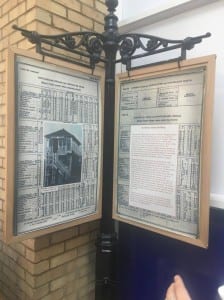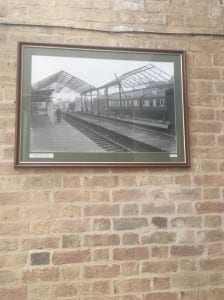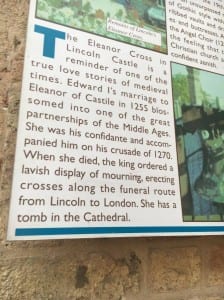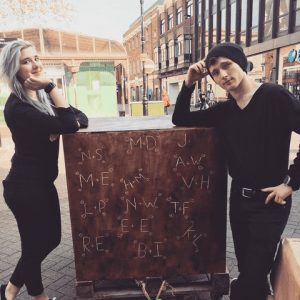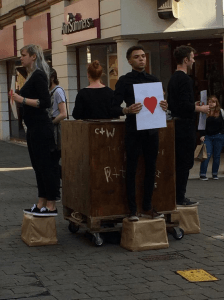Site Specific Blog
Christopher Champion (13391567)
Introduction to “Edward & Eleanor 1254”
Once upon a time King Edward I and his doting wife Eleanor, travelled to Lincoln long ago. The love they shared for one another was absolute. Eternal. Upon arrival in Lincoln they separated in order to enact their formal duties. Unfortunately, during this brief time apart Eleanor died. Edward, was so overcome by grief and remorse that he and his men erected a tall spire within Lincoln castle as a reminder of what he’d left behind, Eleanor’s Cross. Upon his solemn journey with the funeral procession, at every checkpoint, at every small village that they took rest, they then in turn built these spires again and again. This marked the way of their last journey Edward and Eleanor shared and a monument of remembrance of how beautiful it was in her company, and miserable it was without her. When the King arrive in Westminster the funeral was held. Songs were sung, tears were shed and all the people in the land, whispered of the lovers who went to Lincoln.
This was the story that made our site specific performance what it was. We, Mary Jane, Rayanne, Dequaine, Laura and I, researched and experimented with all sorts of different motions and idea’s before coming to this concept. We never abandoned our core objective throughout this process. The outcome of our performance/installation was to make the people aware within our site: The High Street, that they all have on thing that links them all, love. It was this that made us consider if the love people share as they walk side by side, could then be associated with they place they walk.
Our piece commenced with a procession up the high street dragging our interpretation of a modern Eleanor cross that had numerous names and dates of scratched into it taken from the people on the city centre over the previous weeks. We proceeded then to arrive at the central cross roads of the high street where we positioned ourselves in the physical form of a cross whist our monument was left central. In turn we took time to carve more names whilst others would tell the street, afoot small platform boxes, (like a town crier) all the different stories we had collected. Through this performance we have take the admittance of love from a stranger, brought it to life through enacting and proclaiming it then make the symbol of love; their story last forever by carving it into Eleanor’s cross. Whilst speaking the stories to the street we transitioned the way in which they were told to make each story have its own feeling, character and overall uniqueness. After 4 main transitions of speech and carving the piece was drawn to a close and we brought the installation back in a procession down the high street to were we’d started. We finished with answering any question any audience member had. In some cases, we’d have an audience member request their own name on the ‘cross’ which was received well and therefore even in the performance period we were still developing and creating this object, symbol if you will, of the love that lives in Lincoln.
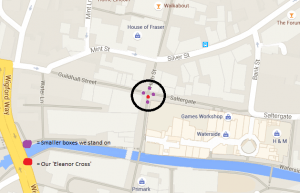
ANALYSIS OF PROCESS OF CREATING “EDWARD & ELEANOR 1254”
In the early weeks, we as a group came together through circumstance due to different idea’s and general uncertainty of what site is? However soon after collaborating and long discussion we came to a clear idea of what we wanted to achieve. Our understanding is that what makes The High Street a ‘place’ is the people that walk up and down it every single day. Going back to the discussion it was apparent early on that we wanted to do something about relationships. This was influenced by our tutor, Steve Fossey. He had shown us a past performance of his own work, where he had stapled hundreds of flowers to a fence. The overall purpose of Steve’s work was quite elusive but our take from it was the memory of hundreds of ‘loved ones’ on one singular fence to symbolise the amount of grief there is in the world. This inspired us to look at the high street’s inhabitants and how they behaved rather instead of the buildings and overall architecture of the street.
“Marc Augé’s book is a haunting analysis of modern life and in particular those homogenised “non-places” where we spend so much of our time: airports, railway stations, superstores, motorways and international hotel chains. Unlike conventional “anthropological places” (the symbolic site of an altar), these “spaces of circulation, consumption and communication” exist beyond history, relations and the game of identity.”
(PD SMITH, 2009) It was only in the fifth week of study we looked Marc Augé and his idea’s on what a ‘place’ and ‘non place’ was. Differentiating the two by suggesting that a place is a place of happening. Therefore, a non place was branded as a place of transition: a way to get somewhere else. If the High St. is considered into this equation, then surely being the shopping central of the city, the walkway its self is a place of transition from one shop to another, and labelled as a non place. Though this seemed evident when confronted with a busking choir whilst researching for our performance, we noticed that with a simple symbolic gesture of good will, shown through singing of a hymn, subsequently gathered a crowd circulating this troop of religious folk singers. It seemed obvious that though the street was a branded ‘non place’, the people of Lincoln are longing, subconsciously begging for it to have some sort of relevance or meaning. But yet after another day fully observing the passers by, the only thing that came to be noticed is that people tended to walk in couples, often hand in hand. After all, it is the most secure, safe area of Lincoln with over 87 CCTV camera’s covering our performance site alone.
Whilst the other researched into famous couples and Lincoln I then took it upon myself to delve a little deeper into the history of the high street. Being aware of a focus which was the idea of couples, relationships I decided to look at part town criers within the city itself. This idea cam to me because I thought if people got married way back when, would the town crier have declared it? Although historical content was extremely limited in this area I did find out that the position of a Town Crier in Lincoln has been occupied for the last two centuries’, however on in 2011 was it declared a state occupancy and only then was the position paid and paid for by the local county council. Upon taking this back to the group we had collectively gathered very different segments of knowledge. We had looked further into “Partly cloudy, Chance of rain” and the concept of exchanging an item for a section of personal information. This was incorporated by Mary Jane so for in order to understand the relationships within Lincoln, we would have to go out research and ask the public and this allowed us to do that without getting to personal and with that extra little touch i.e. flowers we could get exactly what we wanted: love stories. We then came to a communal understanding that from the research we had committed to, our piece looked like it would consist of collecting stories in exchange for flowers, telling the stories like the ‘Town Crier’ whilst having some kind of grand installation to, more than any other reason at this point, draw the eye of passing audience members.
With this clear concept in mind we ventured through the city in search of stories for our collection. After some but little success we stopped out Lakeland Pottery Barn whilst I went in to ask the staff about the building itself, for it is a magnificent building with columns and arches all through it. The store assistant made myself aware that this used to be the old train station before it had to be moved due to traffic congestion and building maintenance such as a replacement roof. The Lakelands shared the building with the local ARGOS so we ventured inside to see what it would have looked like. Whilst in ARGOS we came across a lovely elderly Couple who had been married for over fifty years. They approached us as we were admiring the photo’s and the made it apparent that they had been together when the old train station stood. We dug deeper to unearth that Colin, the gentlemen had caught the train every day from Newark to Lincoln, originally for his place of work, but then after, for his lovely wife Cathy. He said he hated that train and he was only contracted to take if for 3 of 20 years he took it, and that was due from work. As we spoke with the couple for their story was inspirational to say the least, they mentioned that their story resembles the story of the King Edward I and Queen Eleanor. Honestly, we had no clue of this story, nor did we know much on the the monarchs in Lincoln. Lucky for us there was a sign next to the photos, to left of where we’d been looking already that told us just enough to have a clearer understanding of the story which turned out to have absolute relevance to what we were aiming to achieve.
I offered without hesitation to build, craft our own Eleanor cross with scrap wood sourced from Lincolns street. Weeks passed and unfortunately, the pallets I’d collected couldn’t be taken apart. We compromised by building a 90cm by 90cm box from fibre wood sourced from B&Q. Then found a pallet and screwed nails into it so the box could be easily transported. At this point, as a group, our piece was demonstration of love, through declarations, conversations and the carving of names to ensure the memory’s survival. We met with Conan, the module leader, and he advised us to paint the box so it looked appealing, Speech had to be clearly defined when it was a ‘Crier’ speaking and when its just ‘us’ telling a story. Therefor the box had to painted to look aesthetically pleasing. I purchased the woodstain and spent a weekend in the sun painting and carving into and on the sides of the box.
After the paint job and DIY we came together to discuss what our piece achieves because I wasn’t to clear on why we were doing what we were doing. We as a group wanted to experiment with relationships in Lincoln and see if those feeling could transcend into the space we perform. This can make the audience to share memories of when love existed in their lives or how important it was, what they carved on a tree when younger. “We often pressure the memory of an indefinable charm from this town we’ve merely brushed against. The memory indeed of our own indecision, our hesitant footsteps, our gaze which didn’t know what to turn towards and that found l most anything affecting.”(Perec,G.1977, 64) The carving gave the entire piece that personal, real feeling. Much like when you find carvings in a tree, it triggers memories of your own that can relate, so to take away the base object: a tree and carve instead onto a box in the centre on the high street, allowed us to give the audience and people passing this same emotional memory which came from associating wit a box on Lincolns High Street. This became the obsession of our piece. Everywhere you look on the high street today, you can see that its new, modern and really quite devoid of character; “only infrequently are there trees in the streets. When ther are, they have railing surrounding them […] Thus there are street lights which go on automatically as soon as day light begins to decline.”(Perec,G,1977,47) Our overall intension came about to be that we wished to add a little character to the street itself whilst reminding all that love is always in the air.
Also following our final showing to Conan, we focused on the speech itself. We had many ‘everyday’ stories but as a ‘Town Crier’ the majority of these stories couldn’t be read properly and sound formal. Rayanne devised an idea where if the Crier gives the news, i.e.: Mary and Joseph, Wed 1987. Then follows with stepping of his plinth, he could tell the rest to any audience member listening. We had noticed that in the earlier weeks’ people responded to the shouting. At first people might’ve been intimidated however once past the initial shock the words spoken then has a much more profound meaning to any listener. This was inspired by Mike Pearsons “Site Specific Performance” and his idea’s of the different uses and styles about reading text. “The insertion of a classical or modern text in this ‘found space’ throws new light on it, gives it an unsuspected power and places the audience at an entirely different relationship to the fact, the place and the purpose of being there.” (Pearson,M,2010,7) Through our transitions in speech and the overall manner in which the stories we told, we believe that we achieved Mike Pearson’s theory throughout our performance.
PERFORMANCE EVALUATION
Our performance itself went as well as it could have been. There were of course some uncontrollable eventualities that took place which disrupted the overall flow. Such as Dequaine didn’t know what to say when coming to carve, even after spending eleven weeks on this process, he still had no idea what we we doing, also the procession to and from the site was a failure due to the heaviness of the box, it was simply impossible to drag the extremely heavy box with the strength of one of my legs as I am not that strong. On the other hand, the audience was fantastic, even interrupted the performance to enquire on our presence. These things were prepared for and dealt with very professionally and therefore had little impact on the piece overall. Personally, I am not a practitioner, I am an actor. Site specific was the opposite to what I enjoy and love about Drama. I found the final product was what we had envisioned yet for me still lacked that strong performance element I am used to seeing on stage. This was our fault, we spent too much time on the installation rather than the performance. The carvings on the day were much more personal, audience members came close to see exactly what we were carving. This created a kind of intimate feeling we had not expected. Whilst people past us by during our show I heard many anonymous voices saying “It’s a love box”, so I have little to no doubt that we achieved what we wanted to through this performance and the installation. I however will take a few to many years before delving back into Site Specific Performance.
Reference List:
P,D,SMITH. 2009 GUARDIAN REVIEW: Available at :
:http://www.theguardian.com/books/2009/mar/28/non-places-marc-auge-review
M, PEARSON. 2010, 7 “Site specific Performance”, Macmillan Hampshire, London.
G, Perec. 1977, 47-64. “Species of space and other pieces”, Penquin publishers, London: routledge.
Auge, M. (2009) Non-Places: Introduction to an Anthropology of Supermodernity. London: routledge.
